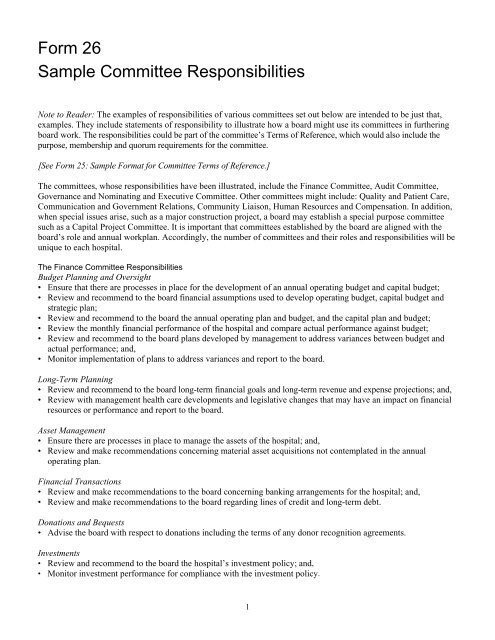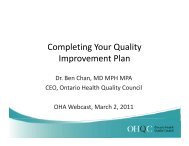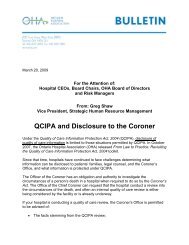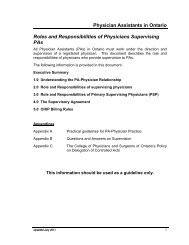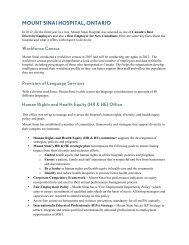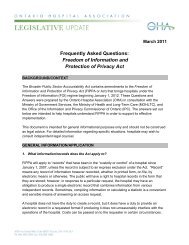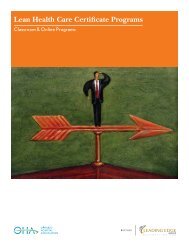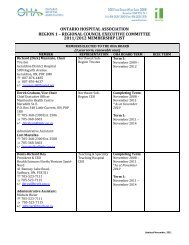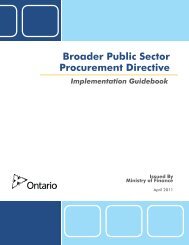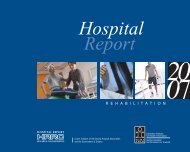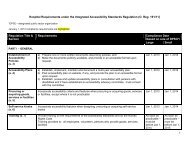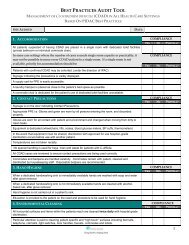Form 26 Sample Committee Responsibilities
Form 26 Sample Committee Responsibilities
Form 26 Sample Committee Responsibilities
- No tags were found...
You also want an ePaper? Increase the reach of your titles
YUMPU automatically turns print PDFs into web optimized ePapers that Google loves.
<strong>Form</strong> <strong>26</strong><strong>Sample</strong> <strong>Committee</strong> <strong>Responsibilities</strong>Note to Reader: The examples of responsibilities of various committees set out below are intended to be just that,examples. They include statements of responsibility to illustrate how a board might use its committees in furtheringboard work. The responsibilities could be part of the committee’s Terms of Reference, which would also include thepurpose, membership and quorum requirements for the committee.[See <strong>Form</strong> 25: <strong>Sample</strong> <strong>Form</strong>at for <strong>Committee</strong> Terms of Reference.]The committees, whose responsibilities have been illustrated, include the Finance <strong>Committee</strong>, Audit <strong>Committee</strong>,Governance and Nominating and Executive <strong>Committee</strong>. Other committees might include: Quality and Patient Care,Communication and Government Relations, Community Liaison, Human Resources and Compensation. In addition,when special issues arise, such as a major construction project, a board may establish a special purpose committeesuch as a Capital Project <strong>Committee</strong>. It is important that committees established by the board are aligned with theboard’s role and annual workplan. Accordingly, the number of committees and their roles and responsibilities will beunique to each hospital.The Finance <strong>Committee</strong> <strong>Responsibilities</strong>Budget Planning and Oversight• Ensure that there are processes in place for the development of an annual operating budget and capital budget;• Review and recommend to the board financial assumptions used to develop operating budget, capital budget andstrategic plan;• Review and recommend to the board the annual operating plan and budget, and the capital plan and budget;• Review the monthly financial performance of the hospital and compare actual performance against budget;• Review and recommend to the board plans developed by management to address variances between budget andactual performance; and,• Monitor implementation of plans to address variances and report to the board.Long-Term Planning• Review and recommend to the board long-term financial goals and long-term revenue and expense projections; and,• Review with management health care developments and legislative changes that may have an impact on financialresources or performance and report to the board.Asset Management• Ensure there are processes in place to manage the assets of the hospital; and,• Review and make recommendations concerning material asset acquisitions not contemplated in the annualoperating plan.Financial Transactions• Review and make recommendations to the board concerning banking arrangements for the hospital; and,• Review and make recommendations to the board regarding lines of credit and long-term debt.Donations and Bequests• Advise the board with respect to donations including the terms of any donor recognition agreements.Investments• Review and recommend to the board the hospital’s investment policy; and,• Monitor investment performance for compliance with the investment policy.1
<strong>Form</strong> <strong>26</strong><strong>Sample</strong> <strong>Committee</strong> <strong>Responsibilities</strong>Internal Controls and Risk Management• Oversee, review and make recommendations to the board concerning management’s risk management processes;• Review and make recommendations concerning the adequacy of financial resources;• Review and make recommendations concerning insurance coverage;• Identify unusual risks and oversee management’s plan to address unusual or unanticipated risks and makerecommendations to the board; and,• Review and make recommendations concerning the quality and integrity of management’s internal controls.Other• Such other matters as may be referred by the board, from time to time.Audit <strong>Committee</strong> <strong>Responsibilities</strong>• Recommend to the board the auditors for appointment or re-appointment by the members at the annual meeting;• Review and make recommendations to the board concerning auditors remuneration;• Meet with auditors to review proposed scope of audit;• Approve auditor’s engagement letter;• Oversee performance of audit as required, including ensuring auditors are receiving the assistance of management;• Review audited financial statements and auditor’s report and make recommendations to the board;• Meet with auditors and receive and review recommendations with respect to management, accounting systems andinternal control issues;• Review policies regarding financial operations, including internal controls;• Review non-audit services provided by auditor and other factors that might compromise the auditor’sindependence and make recommendations to ensure auditor independence;• Review management response to recommendations of auditor and report to the board;• Oversee implementation of auditor’s recommendations; and,• Such other responsibilities as are assigned by the board.Note to Reader: The Audit <strong>Committee</strong> may be a separate committee or a sub-committee of the Finance <strong>Committee</strong>.The Audit <strong>Committee</strong> should be comprised of individuals who are financially literate and should consist of directorswho are independent of management. Only directors should be members of the Audit <strong>Committee</strong>.Board Governance and Nominating <strong>Committee</strong> <strong>Responsibilities</strong>Board Recruitment• Develop for approval by the board a description of the skills, experience and qualities including diversity of thedirectors;• Consider skills, experience, qualities and diversity of current directors to determine board needs; and,• Oversee board recruitment and nomination process and recommend to the board candidates for election at theannual meeting.Board Education• Ensure a comprehensive orientation session is provided to all new board members;• Oversee board education sessions to ensure board receives periodic education on governance, health care issuesand the hospitals operations; and,• Organize, with the input of the CEO and board chair, the board’s annual retreat.2
<strong>Form</strong> <strong>26</strong><strong>Sample</strong> <strong>Committee</strong> <strong>Responsibilities</strong>Board Chair• Ensure succession planning for the office of board chair;• Oversee and implement the board’s process for selecting a board chair and recommend an individual for electionby the board as chair; and,• Make recommendations to the board for vice chairs and other board officers.Board <strong>Committee</strong>s• Ensure periodic review and evaluation of committee performance and Terms of Reference and makerecommendations to the board as required; and,• Recommend to the board, with the input of the chair, nominees for all board committees and committee chairs.Evaluations• Establish and implement a program to evaluate board performances including individual director performance,performance of the chair, board committees and committee chairs;• Consider the results of board evaluations in connection with renewal of the terms of existing directors; and,• Review and make recommendations to the board concerning: Board composition Board size Board structures Board policies and procedures By-law amendments Board attendanceOther• Such other matters as may be required by the board, from time to time.Executive <strong>Committee</strong> <strong>Responsibilities</strong>• Ensure that a strategic planning process is undertaken with board involvement and eventual approval to the board;• Develop a process to oversee the performance and compensation of the CEO by:* Developing a position description for the CEO for approval by the board; Overseeing CEO recruitment, selection and succession planning; Reviewing and recommending to the board the CEO’s annual objectives; Developing and conducting a process to review the performance by the CEO and report the results to the board; and, Recommending CEO compensation for approval by the board.• Oversee CEO’s supervision of management and management succession plans;• Develop and recommend to the board, the board’s annual work plan;• Provide advice and support to the chair, CEO and Chief of Staff and committee chairs;• [For those Executive <strong>Committee</strong>s that are given decision-making authority.] Make decisions binding on the boardin situations where it is not possible or practical to call a meeting of the board, or where the board has authorizedthe committee to act and report the decision at the next board meeting; and,• Undertake such other activities as may be authorized by the board, from time to time.* [Comparable provisions for Chief of Staff and board-appointed medical leaders would also be included ifassigned to the Executive <strong>Committee</strong>];3
<strong>Form</strong> <strong>26</strong><strong>Sample</strong> <strong>Committee</strong> <strong>Responsibilities</strong>Note to Reader: The above is an example of the responsibilities that might be included in an Executive <strong>Committee</strong>Terms of Reference. Not all hospitals have an Executive <strong>Committee</strong>. In cases where there is no Executive<strong>Committee</strong>, the responsibilities would then either reside with the full board, or may be assigned to anothercommittee.4


